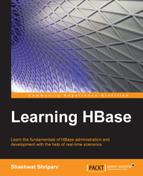We can map an HBase table to Hive (browse https://hive.apache.org if you don't know about Hive already) and run Hive queries that support Hive Query Language (HQL) almost in the same way as SQL on an HBase table. This is good for developers or users who possess a good knowledge of SQL.
For this, we need to create a table in HBase. Let's start the process:
Create a table in Hive as follows:
create 'hivehbasetable', 'name'
Put some data into it:
put 'hivehbasetable', 'row1', 'name:firstname', 'shashwat' put 'hivehbasetable', 'row1', 'name:lastname', 'shriparv' put 'hivehbasetable', 'row1', 'name:title', 'mr'
We need some JAR files for this association (Hive needs to be told where these JARs are), which are as follows:
Guava.<version>.jarHive-Hbase handler.<version>.jarHBase.<version>.jarZookeeper.<version>.jar
Then, we will create an external table in Hive, which will map the HBase table to Hive. Start Hive with following command:
hive --auxpath /usr/lib/hive/lib/hbase.jar,/usr/lib/hive/lib/hive-hbase-handler-<version>.jar, /usr/lib/hive/lib/zookeeper.jar,/usr/lib/hive/lib/guava-<version>.jar
To prevent library-related errors, use the following command:
CREATE EXTERNAL TABLE hivehbasetablemapped (key string, userid string, bookid string, rating int) STORED BY 'org.apache.hadoop.hive.hbase.HBaseStorageHandler' WITH SERDEPROPERTIES ("hbase.columns.mapping" = ":key,name:firstname,name:lastname,name:title") TBLPROPERTIES ("hbase.table.name" = "hivehbasetable");
Alternatively, you can use the following command:
CREATE TABLE hivehbasetablemapped (key string, userid string, bookid string, rating int) STORED BY 'org.apache.hadoop.hive.hbase.HBaseStorageHandler' WITH SERDEPROPERTIES ("hbase.columns.mapping" = ":key,name:firstname,name:lastname,name:title") TBLPROPERTIES ("hbase.table.name" = "hivehbasetable");
Here, the first column is the key column, which will be taken as HBase RowKey. If we have some numeric column, we can use age:age#field in the mapping.
Once we finish the preceding process successfully, we can execute a SQL query in Hive as follows:
hive > select * from hivehbasetablemapped;
We can also perform other operations on Hive.
Note
For further details on this, visit https://cwiki.apache.org/confluence/display/Hive/HBaseIntegration.
